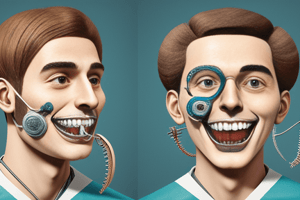Podcast
Questions and Answers
Why are functional appliances used to correct overjet?
Why are functional appliances used to correct overjet?
- To facilitate tooth extraction
- To enhance mandibular posture
- To reduce the risk of tooth decay
- To improve profile and smile esthetics (correct)
Which type of functional appliance is mostly used to correct Class II malocclusion?
Which type of functional appliance is mostly used to correct Class II malocclusion?
- Herbst appliance
- Twin block appliance (correct)
- Frankel appliance
- Bionater
In which type of malocclusion is the Frankel appliance typically used?
In which type of malocclusion is the Frankel appliance typically used?
- Class I malocclusion
- Class III malocclusion (correct)
- Mixed dentition malocclusion
- Class II malocclusion
What is the purpose of the acrylic shields in the Frankel appliance?
What is the purpose of the acrylic shields in the Frankel appliance?
Which type of appliance has bite blocks that posture the mandible forward?
Which type of appliance has bite blocks that posture the mandible forward?
What is the main function of the soft tissue-borne Frankel appliance?
What is the main function of the soft tissue-borne Frankel appliance?
What is the purpose of the bionator appliance?
What is the purpose of the bionator appliance?
What is the advantage of the fixed functional appliance mentioned?
What is the advantage of the fixed functional appliance mentioned?
Why is the Andresen activator considered a loose-fitting monobloc appliance?
Why is the Andresen activator considered a loose-fitting monobloc appliance?
Which appliance connects the upper and lower teeth, resulting in constant forward biting?
Which appliance connects the upper and lower teeth, resulting in constant forward biting?
What was the original purpose of the bionator appliance?
What was the original purpose of the bionator appliance?
Why is the fixed functional appliance not commonly used?
Why is the fixed functional appliance not commonly used?
What is the purpose of taking a 'working bite' in constructing functional appliances?
What is the purpose of taking a 'working bite' in constructing functional appliances?
Why is it important for the patient to move anteriorly while taking the 'working bite' for functional appliances?
Why is it important for the patient to move anteriorly while taking the 'working bite' for functional appliances?
What is the recommended gap when positioning the mandible forward for functional appliances?
What is the recommended gap when positioning the mandible forward for functional appliances?
Which of the following is a common skeletal requirement for using functional appliances?
Which of the following is a common skeletal requirement for using functional appliances?
How do functional appliances primarily affect dental relationships in Class II div I cases?
How do functional appliances primarily affect dental relationships in Class II div I cases?
Which of the following best describes the role of functional appliances in altering skeletal relationships?
Which of the following best describes the role of functional appliances in altering skeletal relationships?
Flashcards are hidden until you start studying
Study Notes
Functional Appliances and Overjet Correction
- Functional appliances are used to correct overjet by modifying jaw relationships and stimulating bone growth.
- Class II malocclusion is commonly corrected using the functional appliance known as the bionator.
Frankel Appliance
- The Frankel appliance is typically used for Class II malocclusion.
- Acrylic shields in the Frankel appliance help to redirect soft tissue pressures, facilitating proper jaw alignment.
Bite Blocks and Mandibular Posture
- Bite blocks in certain functional appliances posture the mandible forward to improve occlusion.
- The soft tissue-borne Frankel appliance primarily supports functional jaw movements and guides dental eruption.
Bionator Appliance
- The bionator appliance serves to expand the dental arch and promote anterior teeth alignment by encouraging forward mandibular posture.
- Originally, the bionator appliance aimed to create space in the dental arch and improve the fit of the teeth.
Fixed Functional Appliances
- Fixed functional appliances provide continuous forward biting by connecting upper and lower teeth.
- They are less commonly used due to factors such as dietary restrictions and patient discomfort.
Working Bite in Appliance Construction
- A 'working bite' is taken when constructing functional appliances to ensure proper alignment of teeth in the desired position.
- It's essential for patients to move anteriorly during the 'working bite' to achieve the correct jaw posture and maximize appliance effectiveness.
Mandibular Positioning
- The recommended gap for positioning the mandible forward typically is 2-3 mm to achieve optimal functionality of the appliances.
Common Skeletal Requirements
- A common skeletal requirement for using functional appliances is the presence of a Class II skeletal relationship that can benefit from treatment.
Effects on Dental Relationships
- Functional appliances primarily affect dental relationships in Class II division I cases by retraining the position of the maxillary and mandibular teeth.
- The role of functional appliances in altering skeletal relationships involves promoting growth changes, repositioning the mandible, and correcting discrepancies between the dental arches.
Studying That Suits You
Use AI to generate personalized quizzes and flashcards to suit your learning preferences.




